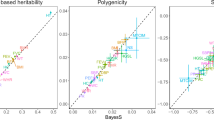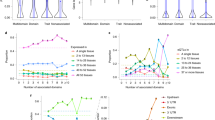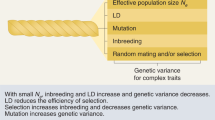Abstract
Characterizing the natural selection of complex traits is important for understanding human evolution and both biological and pathological mechanisms. We leveraged genome-wide summary statistics for 870 polygenic traits and attempted to quantify signals of selection on traits of different forms in European ancestry across four periods in human history and evolution. We found that 88% of these traits underwent polygenic change in the past 2,000–3,000 years. Recent selection was associated with ancient selection signals in the same trait. Traits related to pigmentation, body measurement and nutritional intake exhibited strong selection signals across different time scales. Our findings are limited by our use of exclusively European data and the use of genome-wide association study data, which identify associations between genetic variants and phenotypes that may not be causal. In sum, we provide an overview of signals of selection on human polygenic traits and their characteristics across human evolution, based on a European subset of human genetic diversity. These findings could serve as a foundation for further populational and medical genetic studies.
This is a preview of subscription content, access via your institution
Access options
Access Nature and 54 other Nature Portfolio journals
Get Nature+, our best-value online-access subscription
$29.99 / 30 days
cancel any time
Subscribe to this journal
Receive 12 digital issues and online access to articles
$119.00 per year
only $9.92 per issue
Buy this article
- Purchase on Springer Link
- Instant access to full article PDF
Prices may be subject to local taxes which are calculated during checkout








Similar content being viewed by others
Data availability
All GWAS summary statistics analysed in the current study could be downloaded from the public domain. All data generated in the current study could be obtained from the Supplementary Information.
Code availability
Scripts used for this study is available at https://github.com/WeiCSong/selection.
References
Mathieson, I. Human adaptation over the past 40,000 years. Curr. Opin. Genet. Dev. 62, 97–104 (2020).
Bersaglieri, T. et al. Genetic signatures of strong recent positive selection at the lactase gene. Am. J. Hum. Genet. 74, 1111–1120 (2004).
Kelly, A. J., Dubbs, S. L. & Barlow, F. K. An evolutionary perspective on mate rejection. Evol. Psychol. 14, 1–13 (2016).
Gibson, M. A. & Lawson, D. W. Applying evolutionary anthropology. Evol. Anthropol. 24, 3–14 (2015).
Wells, J. C. K., Nesse, R. M., Sear, R., Johnstone, R. A. & Stearns, S. C. Evolutionary public health: introducing the concept. Lancet 390, 500–509 (2017).
Currat, M. et al. Molecular analysis of the β-globin gene cluster in the Niokholo Mandenka population reveals a recent origin of the β(S) Senegal mutation. Am. J. Hum. Genet. 70, 207–223 (2002).
Kircher, M. et al. A general framework for estimating the relative pathogenicity of human genetic variants. Nat. Genet. 46, 310–315 (2014).
Pritchard, J. K., Pickrell, J. K. & Coop, G. The genetics of human adaptation: hard sweeps, soft sweeps, and polygenic adaptation. Curr. Biol. 20, R208–R215 (2010).
Laland, K. N., Odling-Smee, J. & Myles, S. How culture shaped the human genome: bringing genetics and the human sciences together. Nat. Rev. Genet. 11, 137–148 (2010).
Esteller-Cucala, P. et al. Genomic analysis of the natural history of attention-deficit/hyperactivity disorder using Neanderthal and ancient Homo sapiens samples. Sci. Rep. 10, 8622 (2020).
Pardiñas, A. F. et al. Common schizophrenia alleles are enriched in mutation-intolerant genes and in regions under strong background selection. Nat. Genet. 50, 381–389 (2018).
Watanabe, K. et al. A global overview of pleiotropy and genetic architecture in complex traits. Nat. Genet. 51, 1339–1348 (2019).
Hejase, H. A., Dukler, N. & Siepel, A. From summary statistics to gene trees: methods for inferring positive selection. Trends Genet. 36, 243–258 (2020).
Bycroft, C. et al. The UK Biobank resource with deep phenotyping and genomic data. Nature 562, 203–209 (2018).
Malik, R. et al. Multiancestry genome-wide association study of 520,000 subjects identifies 32 loci associated with stroke and stroke subtypes. Nat. Genet. 50, 524–537 (2018).
Lawn, R. B. et al. Schizophrenia risk and reproductive success: a Mendelian randomization study. R. Soc. Open Sci. 6, 181049 (2019).
Bribiescas, R. G. Men: Evolutionary and Life History (Harvard Univ. Press, 2009).
Morrison, J., Knoblauch, N., Marcus, J. H., Stephens, M. & He, X. Mendelian randomization accounting for correlated and uncorrelated pleiotropic effects using genome-wide summary statistics. Nat. Genet. 52, 1–8 (2020).
Barban, N. et al. Genome-wide analysis identifies 12 loci influencing human reproductive behavior. Nat. Genet. 48, 1–7 (2016).
Burgess, S., Davies, N. M. & Thompson, S. G. Bias due to participant overlap in two-sample Mendelian randomization. Genet. Epidemiol. 40, 597–608 (2016).
Field, Y. et al. Detection of human adaptation during the past 2000 years. Science 354, 760–764 (2016).
Sohail, M. et al. Polygenic adaptation on height is overestimated due to uncorrected stratification in genome-wide association studies. eLife 8, e39702 (2019).
Edge, M. D. & Coop, G. Reconstructing the history of polygenic scores using coalescent trees. Genetics 211, 235–262 (2019).
Speidel, L., Forest, M., Shi, S. & Myers, S. R. A method for genome-wide genealogy estimation for thousands of samples. Nat. Genet. 51, 1321–1329 (2019).
Janus, L. Two corner stones of the psychobiological development of mankind - The increase in frequency of pregnancies in the neolithic revolution and ‘physiological prematurity’. Nutr. Health 19, 63–68 (2007).
Lipson, M. et al. Parallel palaeogenomic transects reveal complex genetic history of early European farmers. Nature 551, 368–372 (2017).
Fu, Q. et al. The genetic history of Ice Age Europe. Nature 534, 200–205 (2016).
Lazaridis, I. et al. Genomic insights into the origin of farming in the ancient Near East. Nature 536, 419–424 (2016).
Sankararaman, S. et al. The genomic landscape of Neanderthal ancestry in present-day humans. Nature 507, 354–357 (2014).
Palamara, P. F., Terhorst, J., Song, Y. S. & Price, A. L. High-throughput inference of pairwise coalescence times identifies signals of selection and enriched disease heritability. Nat. Genet. 50, 1311–1317 (2018).
Grossman, S. R. et al. A composite of multiple signals distinguishes causal variants in regions of positive selection. Science 327, 883–886 (2010).
Mughal, M. R. & DeGiorgio, M. Localizing and classifying adaptive targets with trend filtered regression. Mol. Biol. Evol. 36, 252–270 (2019).
Cheng, X. & DeGiorgio, M. Flexible mixture model approaches that accommodate footprint size variability for robust detection of balancing selection. Mol. Biol. Evol. https://doi.org/10.1093/molbev/msaa134 (2020).
Gazal, S. et al. Linkage disequilibrium-dependent architecture of human complex traits shows action of negative selection. Nat. Genet. 49, 1421–1427 (2017).
Sardá-Espinosa, A. Time-series clustering in R using the dtwclust package. R J. 11, 22–43 (2019).
Chen, M. et al. Evidence of polygenic adaptation in Sardinia at height-associated loci ascertained from the biobank Japan. Am. J. Hum. Genet. 107, 60–71 (2020).
Daub, J. T. et al. Evidence for polygenic adaptation to pathogens in the human genome. Mol. Biol. Evol. 30, 1544–1558 (2013).
1000 Genomes Project Consortium. A global reference for human genetic variation. Nature 526, 68–74 (2015).
Rocha, J. The evolutionary history of human skin pigmentation. J. Mol. Evol. 88, 77–87 (2020).
Luca, F., Perry, G. H. & Di Rienzo, A. Evolutionary adaptations to dietary changess. Annu. Rev. Nutr. 30, 291–314 (2010).
Little, M. A. Evolutionary strategies for body size. Front. Endocrinol. 11, 107 (2020).
Södersten, P., Brodin, U., Zandian, M. & Bergh, C. Eating behavior and the evolutionary perspective on anorexia nervosa. Front. Neurosci. 13, 596 (2019).
Ewald, P. W. & Swain Ewald, H. A. An evolutionary perspective on the causes and treatment of inflammatory bowel disease. Curr. Opin. Gastroenterol. 29, 350–356 (2013).
Hill, W. G. & Robertson, A. The effect of linkage on limits to artificial selection. Genet. Res. (Camb.). 89, 311–336 (2008).
Maruyama, T. The age of a rare mutant gene in a large population. Am. J. Hum. Genet. 26, 669–673 (1974).
Charlesworth, B. Fundamental concepts in genetics: effective population size and patterns of molecular evolution and variation. Nat. Rev. Genet. 10, 195–205 (2009).
Martin, A. R. et al. Clinical use of current polygenic risk scores may exacerbate health disparities. Nat. Genet. 51, 584–591 (2019).
Hemani, G. et al. The MR-base platform supports systematic causal inference across the human phenome. eLife 7, e34408 (2018).
Bowden, J., Davey Smith, G., Haycock, P. C. & Burgess, S. Consistent estimation in mendelian randomization with some invalid instruments using a weighted median estimator. Genet. Epidemiol. 40, 304–314 (2016).
Bowden, J., Davey Smith, G. & Burgess, S. Mendelian randomization with invalid instruments: effect estimation and bias detection through Egger regression. Int. J. Epidemiol. 44, 512–525 (2015).
Burgess, S., Bowden, J., Fall, T., Ingelsson, E. & Thompson, S. G. Sensitivity analyses for robust causal inference from mendelian randomization analyses with multiple genetic variants. Epidemiology 28, 30–42 (2017).
Verbanck, M., Chen, C. Y., Neale, B. & Do, R. Detection of widespread horizontal pleiotropy in causal relationships inferred from Mendelian randomization between complex traits and diseases. Nat. Genet. 50, 693–698 (2018).
Galinsky, K. J. et al. Fast principal-component analysis reveals convergent evolution of ADH1B in Europe and East Asia. Am. J. Hum. Genet. 98, 456–472 (2016).
Purcell, S. et al. PLINK: A tool set for whole-genome association and population-based linkage analyses. Am. J. Hum. Genet. 81, 559–575 (2007).
Schloerke, B. et al. ggobi/ggally: v2.1.2. Zenodo, https://doi.org/10.5281/zenodo.5009047 (2021).
Lek, M. et al. Analysis of protein-coding genetic variation in 60,706 humans. Nature 536, 285–291 (2016).
McVicker, G., Gordon, D., Davis, C. & Green, P. Widespread genomic signatures of natural selection in hominid evolution. PLoS Genet. 5, e1000471 (2009).
Zeng, J. et al. Bayesian analysis of GWAS summary data reveals differential signatures of natural selection across human complex traits and functional genomic categories. Preprint at https://doi.org/10.1101/752527 (2019).
Haller, B. C. & Messer, P. W. SLiM 3: forward genetic simulations beyond the Wright–Fisher model. Mol. Biol. Evol. 36, 632–637 (2019).
Gravel, S. et al. Demographic history and rare allele sharing among human populations. Proc. Natl Acad. Sci. USA 108, 11983–11988 (2011).
Berisa, T. & Pickrell, J. K. Approximately independent linkage disequilibrium blocks in human populations. Bioinformatics 32, 283–285 (2016).
Berndt, D. J. & Clifford, J. Using dynamic time warping to find patterns in time series. KDD Work. 10, 359–370 (1994).
Hothorn, T., Hornik, K., Wiel, M. Avande & Zeileis, A. Implementing a class of permutation tests: the coin package. J. Stat. Softw. 28, 1–23 (2008).
Acknowledgements
The study was supported by National Natural Science Foundation of China (no. 81971292, G.N.L.), the Natural Science Foundation of Shanghai (no. 21ZR1428600, G.N.L.), the Program for Professor of Special Appointment (Eastern Scholar) at Shanghai Institutions of Higher Learning (grant no. 1610000043, G.N.L.) and the Interdisciplinary Program of Shanghai Jiao Tong University (no. YG2019QNA59, G.N.L.). The authors thank all researchers and consortia that share their GWAS summary statistics with the scientific community. W.S. thanks J. Song for his inspiration on this study.
Author information
Authors and Affiliations
Contributions
G.N.L. designed and supervised the study. Y.S. collected and preprocessed the data. W.S. analysed the data and drafted the manuscript. W.P., W.Q. and W.W. assisted with the methodology. Y.S., S.Y. and M.Z. interpreted the data. All authors read, revised and approved the manuscript.
Corresponding author
Ethics declarations
Competing interests
The authors declare no competing interests.
Additional information
Peer review information Nature Human Behaviour thanks Eugenio Lopez-Cortegano and the other, anonymous, reviewer(s) for their contribution to the peer review of this work.
Publisher’s note Springer Nature remains neutral with regard to jurisdictional claims in published maps and institutional affiliations.
Supplementary information
Supplementary information
Supplementary methods, results and Figs. 1–13.
Rights and permissions
About this article
Cite this article
Song, W., Shi, Y., Wang, W. et al. A selection pressure landscape for 870 human polygenic traits. Nat Hum Behav 5, 1731–1743 (2021). https://doi.org/10.1038/s41562-021-01231-4
Received:
Accepted:
Published:
Issue Date:
DOI: https://doi.org/10.1038/s41562-021-01231-4
This article is cited by
-
Ancient DNA suggests anaemia and low bone mineral density as the cause for porotic hyperostosis in ancient individuals
Scientific Reports (2023)
-
Recent natural selection conferred protection against schizophrenia by non-antagonistic pleiotropy
Scientific Reports (2023)
-
Neandertal introgression partitions the genetic landscape of neuropsychiatric disorders and associated behavioral phenotypes
Translational Psychiatry (2022)
-
Locus-level antagonistic selection shaped the polygenic architecture of human complex diseases
Human Genetics (2022)
-
Selection still shapes our genome
Nature Human Behaviour (2021)



